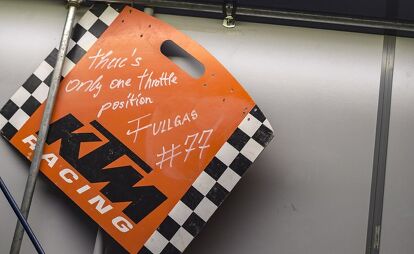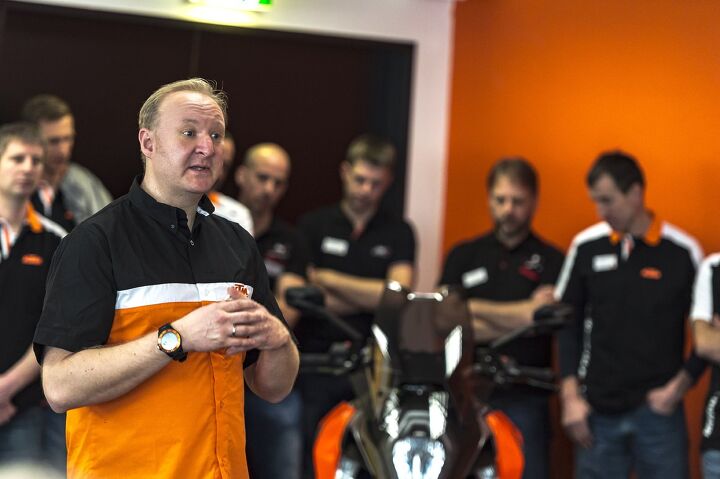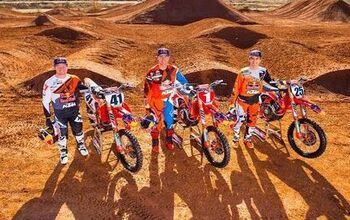A Look Behind The Scenes At KTM

KTM allows outsiders to its R&D facilities for the first time.
It’s fair to say KTM has been on a meteoric rise since Stefan Pierer saved the company from bankruptcy in the early 1990s. Since then, the brand made its name in off-road racing, winning nearly everything under the sun, including 15 consecutive Dakar rallies, and the 2015 AMA Supercross championship with Ryan Dungey.
Dirtbikes may be what KTM is known for, but few know that KTM originally made street motorcycles back in the 1950s. With such a strong presence in the off-road sector, in order to gain marketshare, KTM management realized a return to the street segment was in order. Since 2002, KTM has structured itself not just for a return to the street segment, but to dominate it as KTM has the off-road sector. Early offerings like the 1994 Duke eventually led to models like the Duke II, 990 Superduke, RC8, 1290 Super Duke R, and the upcoming 1290 Super Duke GT. This doesn’t even include small displacement models like the 125 Duke and 390 Duke produced in partnership with Bajaj in India (which owns a 47% stake in KTM).
More models means more success for KTM, resulting in its 24.9% ownership stake in Kiska, the design studio founded by Gerald Kiska, which has designed every KTM for the past 22 years. This growth has also led to a larger staff as well – more than 150 employees have been added to Team Orange since 2010.
To celebrate this success, KTM invited journalists from around the world, including Yours Truly, to its headquarters in Mattighofen, Austria, to learn more about its street division and get a behind-the-scenes look at the company, its people, and its R&D facility. Never before has KTM opened these doors to outsiders, so come along for a pictorial slideshow of the inner workings of KTM.
As far as company spokespeople go, Thomas Kuttruf, Head of Press and Public Relations at KTM, has everything you could ask for. Smart, passionate and enthusiastic, you can tell his excitement about where the company has come, where it is, and where it’s going isn’t fabricated. He eats, sleeps, and breathes KTM’s “Ready To Race” mantra. He’s a pretty good rider, too, acting as one of the lead riders on the 690 Duke introduction. As our host and emcee for the event, Kuttruf knows when to emphasize a point. He demonstrated this whenever an engineer or project leader – folks not typically known for their public speaking prowess, especially in a non-native language – would casually state a point, interjecting to emphasize the significance of what was said.
Philipp Habsburg plays a vital role at KTM. As the VP of Research and Development, he oversees all of KTM’s projects – meaning he’s also the boss of most those people you see in the background. It’s no small task, as, according to Habsburg, there are currently 71 projects – roughly split 50/50 between street and dirt – underway at the moment. And that doesn’t include the 10 to 15 “innovation projects” also underway. These projects aren’t tied to any particular model. Rather, they are used to test and/or verify technologies that could see their way into future models.
Habsburg’s story at KTM begins 17 years ago, when he joined KTM to work on the LC4 engine. He was later promoted to oversee all chassis development before being pushed up once again to his current position as VP of R&D. When he started, R&D consisted of 38 people. Today that number has exploded to 398, split between four divisions (Offroad, Street, Engine, and Components) and 15 departments, housed in KTM’s dedicated R&D facility, built in 1999, that spans 114,097 square feet. For 2015, R&D was allotted a budget of 50 million Euros (roughly $54 million at current exchange rates), which accounts for 5.5% of the company’s total revenue.
Apart from the dedicated R&D facility in Austria, KTM is able to conduct testing for special circumstances almost anywhere in the world. Altitude testing for the Adventure line was conducted in the Alps, while dust testing took place in South Africa.
After obtaining his degree in mechanical engineering, Peter Gorbach was hired on by KTM in 2002 to help develop its racing four-stroke engines, crediting the 250 SX-F engine as his first project. Today, he’s the head of engine development at KTM for both on-road and off-road applications, two-stroke and four-stroke. As you can imagine, that’s no small feat. Under Peter are eight team leaders and six different departments: Thermodynamic Testing and Calculation, Mechanic Testing and Calculation, Engine Design, Exhaust Design, Exhaust Technology, Test Field and Measuring Devices. Later, we’ll get a view of the engine dyno with an explanation of what KTM technicians test for.
When it comes to KTM’s street models, Gerald Matschl is in charge. As Vice President of R&D for the Street, Matschl manages all aspects of street development. Because of KTM’s vast model lineup, the street department is split into three different divisions based on engine displacement: LC8 (Adventure and Super Duke range), Sub-400cc, which includes models like the 390 Duke, RC390, and 125 Duke, and a third group for Midrange models – plural. This includes models using the LC4 engine, like the 690 Duke, but also a new engine platform that will slot between the 690 and the big Twins. Displacement wasn’t confirmed, but will likely be a 800cc parallel-Twin. There’s also a fourth group consisting of designers, mechanics, and a specialized test team dedicated to street models.
As another long-time employee of KTM (joining the company in 1989), Matschl remembers a time when everyone at the company wore every hat. Prior to heading up the Street department, he had a hand in LC4 development and also managed the transition of assets once KTM purchased Husaberg.
Fun fact: The development of the 1190 Adventure, according to KTM, took 160 engineers about 130,000 hours of work.
Martin Forster’s job is incredibly important. As Head of Components Development, it’s his job to make sure all the electronic components on each KTM work together as they should, even in extreme conditions. Obviously that’s a daunting task, and it’s the reason why the Components Development division has the biggest staff of all the divisions, with specialists in electronics development, component design and testing, Engine Management Systems (EMS) and fatigue strength. It’s also his job to oversee prototyping, Noise/Vibration/Harshness (NVH) measurement and homologation.
Since the beginning of KTM’s partnership with Keihin in 2001 (and later with Bosch in 2011), Forster has overseen the development of KTM’s first EMS in 2005, the development of ABS, the first ride-by-wire system, lean-angle-sensitive traction control and ABS, stability control, semi-active suspension, and most recently, the implementation of the first quickshifter in a KTM with the upcoming Super Duke GT.
The organizational chart shown behind Forster highlights the growth within the company, but also just how complex the work matrix can be. There’s a very multi-layered web of people required to bring a new model to life, and the Super Duke GT involved nearly every division and sub-division of KTM due to its complexity.
Followers of KTM’s off-road racing exploits are likely familiar with Pit Beirer. For a company whose tagline is “Ready To Race” it’s only natural a former racer is the head of KTM’s racing department. He emphasized how racing is the proving ground for all the R&D work KTM puts into its motorcycles, noting that tech seen in racing often does trickle down to production models. He was particularly enthusiastic about the recent Dakar rally, in which a factory KTM finished first, a privateer KTM finished second, and a Husqvarna third.
The T in KTM, Hubert Trunkenpolz is KTM’s Chief Sales Officer and descendant of company founder, Hans Trunkenpolz. Present to answer questions regarding the business side of KTM, when asked about the challenges the company is facing, he cited shorter development cycles and greater competition from Japan. “Especially Yamaha,” he said.
As for the company’s return to MotoGP with the RC16, which he says makes something in the ballpark of 270 hp, Trunkenpolz showed guarded enthusiasm about the project, happy with the fact KTM “had reached a volume in sales and R&D staff to be able to commit to MotoGP.” The reservations came with the natural follow-up question by journalists: Will it trickle down to a road bike? Trunkenpolz held firm with the company’s stance that it would not, noting a discomfort in “selling motorbikes capable of over 300 kph (186 mph) and 240 hp.” He did insinuate, however, that a trackday-only model could materialize someday, but that a successor project to the company’s aging RC8 sportbike is not currently underway.
He then turned his attention to the Husqvarna brand, in which he stated it’s the brand KTM can leverage to expand and maneuver into different categories while maintaining KTM’s racing pedigree. “The technologies KTM have can apply to several different segments of motorcycling that KTM aren’t currently in,” he said.
Lastly, on the topic of electrics, Trunkenpolz admitted that the Freeride-E didn’t achieve the sales goals KTM were shooting for, but also stated the aim for the project was to collect data and become a tech leader in the electric segment – a project that isn’t over. KTM sees a future in electric technology, though most likely under the Husqvarna umbrella, to help meet global pollution issues, especially in areas that have restricted the types of vehicles allowed to enter city centers, Paris and Shanghai among them. When asked if we could see KTM or Husqvarna race an electric at the Isle of Man TT, Trunkenpolz replied, “It is a possibility, yes.”
After the series of speeches by the esteemed speakers, it was finally time to peer into the R&D facility. Housed within KTM are 14 engine dynos like the one seen here. Capable of withstanding up to 230 hp and 500 Nm (368 lb-ft.) of torque, here we see an LC8 V-Twin going through testing. Tests can include anything from durability runs up to 186 mph, testing for component strength, or testing for fuel mapping to satisfy the fuel supplied to different countries. When conducting the latter, fuel temps are regulated at 70ºF, and whatever power is generated on the dyno gets fed back into the power grid. KTM estimates it burns through 200,000 liters (nearly 53,000 gallons) of fuel a year feeding the engines on test benches.
In an adjacent room another technician conducts NVH (Noise, Vibration, Harshness) measurements on a roller dyno with a complete motorcycle. Here, up to 140 different sensors can be attached to the motorcycle. From there, the engine is run through its rev range while the sensors record the vibrations given. It’s here that technicians do their best to tune out vibes in the bars or pegs, or anywhere else us moto-journo types might complain about for being “too buzzy.”
Apart from vibrations that could annoy a rider, there are also vibrations that can cause a component to fail. In this particular instance there was a report of battery failures while on a shaker machine. Capable of shaking a component from between 5 to 3,000 hertz, it’s the NVH measurement team’s job to find the source of the problem. The photo above shows a side view of a battery enclosed in its case, as seen from a high-speed camera. At 170 hertz, the battery would physically jump within the casing, eventually leading to failure. Ultimately, the solution was to pad the battery box with thicker foam.
The NVH measurement team also conducts real-world tests, placing data loggers on multiple points throughout a motorcycle before it’s taken for a ride. According to Martin Mayrobnig, the NVH measurement team leader, depending on the application, “NVH testing can take weeks, sometimes months, sometimes even years to finish.”
The final leg of our tour was a stop to the fatigue testing room, where whole motorcycles and individual chassis and suspension components are put through major stress in order to discover any failure points. Under the naked eye, this machine doesn’t appear to be even moving with the wheel underneath it. However, its oscillations are at such a high frequency a strobe light is required for the human eye to see the stress it’s placing on the wheel spokes.
Other areas of the stress room place fork stanchions onto hydraulic arms that bend and flex the component far beyond what even the most aggressive rider might achieve, say, slamming the front wheel on the ground after a wheelie.
The point of this stress testing is to be able to build a component that will meet the strength requirements necessary with the minimum amount of material possible. So much data is collected when putting a machine through stress tests – both in the lab and out in the field – that KTM have five employees whose sole job is to analyze the data to see where material can be removed while still meeting strength goals.
There’s still far more that goes into the creation of a KTM motorcycle, including the design phase at Kiska, KTM’s design partner for more than 20 years. But that will be covered in a future story.

Troy's been riding motorcycles and writing about them since 2006, getting his start at Rider Magazine. From there, he moved to Sport Rider Magazine before finally landing at Motorcycle.com in 2011. A lifelong gearhead who didn't fully immerse himself in motorcycles until his teenage years, Troy's interests have always been in technology, performance, and going fast. Naturally, racing was the perfect avenue to combine all three. Troy has been racing nearly as long as he's been riding and has competed at the AMA national level. He's also won multiple club races throughout the country, culminating in a Utah Sport Bike Association championship in 2011. He has been invited as a guest instructor for the Yamaha Champions Riding School, and when he's not out riding, he's either wrenching on bikes or watching MotoGP.
More by Troy Siahaan


























































Comments
Join the conversation
Nice summary but I'm wary of the claim that 'never before' has KTM opened these doors to outsiders. I'm not sure exactly which doors you are referring to but I've certainly seen a bike mag story from a visit to schloss KTM within the last couple of years.
I'm thinking that the Kiska purchase may not have been the best for KTM. Orange and angles = bleah. Distinctive, yes. Pretty , no.